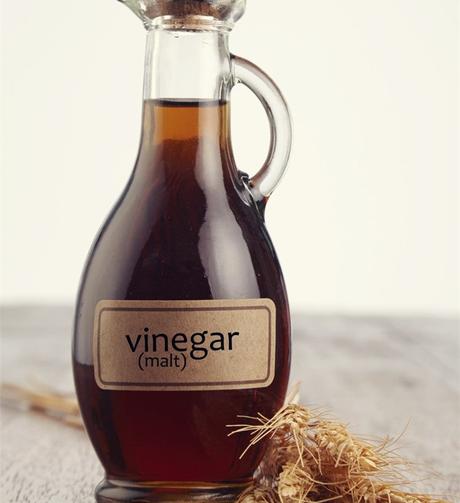
Malt vinegar, made from malted barley, has a mild and sweet taste. It is typically used as a condiment to accompany fish and chips, although it can also be used to add some flavorful richness to a variety of other meals.
Malt vinegar is a staple in cooking, but if you don't have it on hand, you can use these malt vinegar substitutes to get a similar outcome in your dishes. These substitutes will bring a subtle change in flavor to your dishes but will work in a pinch.
1. Apple Cider Vinegar
Made from fermented apples, apple cider vinegar has a sharp acidity and flavor, similar to malt vinegar, but with a subtle sweetness to it. Apple cider vinegar also offers a range of health benefits, making it a popular choice for many.
Apple cider vinegar and malt vinegar have similar flavor profiles and levels of acidity, so you can use one to replace the other in marinades, salad dressings, soups, sauces, vinaigrettes, and more. It's also low in calories and makes for a perfect substitute for those who are avoiding malt vinegar due to gluten sensitivity.
1 tablespoon malt vinegar = 1 tablespoon apple cider vinegar.
2. Balsamic Vinegar
Balsamic vinegar is a fermented grape product. It's a thick liquid with a darker color than malt vinegar, but its sweet-sour flavor makes it a good replacement for malt vinegar in some dishes. Authentic balsamic vinegar is typically aged for 12 years, although you may also find some varieties that are aged upwards of 25 years.
Balsamic vinegar has the perfect balance of acidity and sweetness, making it wonderful in salads, vinaigrettes, dressings, and dipping sauces and with fried foods, steaks, seafood, pasta, pizza, and other dishes. When using it as a substitute, make sure to use good-quality balsamic vinegar as the less-costly variety tends to have a strong acidic taste that will make you pucker.
1 tablespoon malt vinegar = 1 tablespoon balsamic vinegar.
(Use cheaper varieties in a 1:1 ratio, but reduce the amount when using thicker varieties.)
3. Lemon Juice
We hear you, lemon juice is nowhere similar to malt vinegar, but this citrusy ingredient still has a mildly tart, acidic flavor and a mellow finish similar to malt vinegar. Plus, you can make it at home, which certainly adds to its appeal.
You can use lemon juice in salads, vegetables, sauces, and many other recipes that call for malt vinegar. As lemon juice is citrusy with hints of sweetness as opposed to the nuttiness of malt vinegar, it will change the flavor of your dish. However, the difference is not really noticeable. It's still a good idea to start with a small amount and adjust as you need to avoid making your dish too "lemony".
1 tablespoon malt vinegar = 1 tablespoon lemon juice.
4. Red Wine Vinegar
Red wine vinegar is created by fermenting red wine. It has a sweet and fruity grape taste that may not be similar to malt vinegar, but it lends itself beautifully to most recipes that call for malt vinegar.
You can use red wine vinegar in salad dressings or a number of other dishes. Its fruitiness and sour, tangy flavor will work well with ingredients like olive oil to enhance the flavor profile of your dish.
1 tablespoon malt vinegar = 1 tablespoon red wine vinegar.
5. Sherry Vinegar
Sherry vinegar, a traditional vinegar in Spain, is made from sherry wine. The wine is aged for a minimum of 6 months to allow the flavor profile to develop. Once mature, it has a similar flavor to malt vinegar but still has some complexity with a deep, nutty kick and a hint of sweetness.
Sherry vinegar is best used to replace malt vinegar in Asian dishes, particularly ones that include peanut and/or peanut sauce. You can also whisk it into a vinaigrette, add it into marinades, use it to flavor your soups, or drizzle it over your dishes for a flavor boost. While sherry vinegar has an intense flavor, it will not affect the flavors of other ingredients in your dish. Hence, you can easily use it in the same way as malt vinegar.
1 tablespoon malt vinegar = 1 tablespoon sherry vinegar.
6. White Wine Vinegar
Made by fermenting white wine in wooden barrels, white wine vinegar has a light yellow color and a mildly sweet and acidic taste. Although its taste is quite distinct from the nutty quality of malt vinegar, the fruitiness is quite subtle. So, white wine vinegar will be suitable for use as a substitute for malt vinegar in a range of recipes.
White wine vinegar's flavor works well in sauces, seafood, chicken, vegetables, and even salad dressing - basically any recipe that calls for malt vinegar. Keep in mind that the taste and acidity level of white wine vinegar depends on how long it was aged. So, you may need to alter the amount you're using to get the desired taste in your dishes.
1 tablespoon malt vinegar = 1 tablespoon white wine vinegar + 1/4 tablespoon sugar (optional).
7. Worcestershire Sauce
Worcestershire sauce is a type of condiment made with ingredients like vinegar and anchovies. It has a pungent, deep flavor similar to that of malt vinegar. Worcestershire sauce also has a rich umami taste that can elevate the flavor of various dishes. So, if you don't have malt vinegar on hand, you can use Worcestershire sauce as a replacement.
The flavor profile of Worcestershire sauce is wonderful in soups and marinades as well as paired with steaks and cheese. When using it as a substitute, keep in mind that Worcestershire sauce has a much more complex flavor than malt vinegar. So, it would be a good idea to start with a small amount and add more after tasting to prevent spoiling your dish.
1 tablespoon malt vinegar = 1/2 tablespoon Worcestershire sauce.
